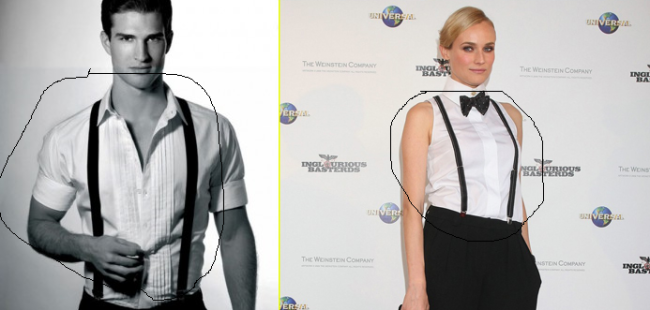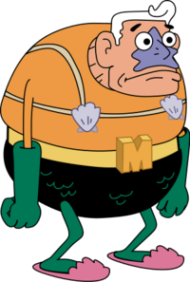Blog Post #5: Superheroes & Superheroines
In the notably famous children’s television show, Spongebob, lies a once great superhero named Mermaidman. A hero to the main character, Spongebob, and his lifelong companion, Patrick Starfish, Mermaidman possesses enhanced superhero-like qualities such as mind control and super strength. He was once a great crime fighting superhero, however, Mermaidman and his partner in crime, Barnacle Boy have now aged and currently reside at Shady Shoals Rest Home. Created by Stephen Hillenburg, Mermaid Man is portrayed as a stereotypical elder. He has white hair, poor sight and hearing, crankiness and memory loss, often forgetting what he is thinking about what he is doing. He appears to suffer from slight elderly dementia he is easily-confused by others’ behavior, though this also could be partly credited with his hearing loss.
The history of Mermaidman and the way he is portrayed in Spongebob can be attributed to the success and popularity of the DC comic book character, Batman. In fact, Stephen Hillenburg, creator of Mermaidman, satirizes and makes a parody of Batman, through Mermaidman’s utilities, powers, and actions. For example, Mermaidman has an invisible boatmobile, which is an obvious parody of Batman’s batmobile. He also has a utility belt that seemed to contain gadgets for any situation, much like Batman’s. In the episode, Back To The Past, young Mermaidman is voiced by Adam West, the same person who voiced Batman for the 60’s TV show, Batman. The fight scenes in this episode contain words such as POW!, BAM!, and SNAP! This was another possible nod to Adam West’s portrayal of Batman. Lastly, Mermaidman’s hideout, Mermalair makes a parody of Batman’s hideout, the Batcave.
Hillenburg creates a parody of these superheroes to reflect upon societies’ views on these heroes during the time (which was at about 1999). Through Mermaidman, Hillenburg made a parody of Batman, to in a sense, symbolize the success of this superhero at the time. In 1997, the film Batman & Robin released in the United States. Directed by Joel Schumacher, Batman & Robin stars many famous actors today, such as George Clooney, Arnold Schwarzenegger, and Uma Thurman. Despite the movie’s wonderful cast, it hit an unbearable limit of “terribly funny.” Critics of Rotten Tomato stated that Batman & Robin was a frantic and mindless movie that’s too jokey to care much for. The movie was so bad that Joel Schumacher publicly apologized.
“If there’s anybody watching this, that… let’s say, loved Batman Forever, and went into Batman & Robin with great anticipation, if I’ve disappointed them in any way, then I really want to apologize. Because it wasn’t my intention. My intention was just to entertain them.” – Joel Schumacher
The moral of this is basically to state that at around the late 1990’s Batman, the notorious vigilante of Gotham City, was viewed as a “joke” to society. Going back to what I said about Stephen Hillenburg and his creation of Mermaidman, it is apparent that Hillenburg created Mermaidman (in 1999) to in a sense, “make fun of”’ and satirize Batman and his success at the time. This noticeable trend of reflecting Mermaidman’s success and screen time to the success of Batman continued on to present day. As society continued to “clown on” Batman, so did Hillenburg. Throughout seasons 1-3 of Spongebob, Batman was considered a joke to society. However, coming into the 4th season of Spongebob , Christopher Nolan directed and released the first of his Batman sequel: Batman Begins. This movie was like no other Batman movie ever released. It received amazing reviews and ratings and really hooked society’s interest back into this mysterious vigilante. Hillenburg responded to societies’ positive outlook on Batman by creating a motion picture episode of Spongebob called Mermaidman and Barnacle boy IV: The Motion Picture. As years continued on and the success of Batman escalated (with the movies The Dark Knight and The Dark Knight Rises), Hillenburg stopped satirizing Batman in his episodes. In fact, he actually creates an episode in 2010 (which was after Batman Begins and The Dark Knight released) called Back To The Past where he displays a young, strong Mermaidman, voiced by Adam West (West voiced Batman for the popular 60’s T.V show, Batman). This show, released in 1966 made Batman extremely popular. Hillenburg creates this episode to praise Mermaidman rather than to make jokes about him. As you can tell, Hillenburg changes his jokes and outlook on Mermaidman as society changes their outlook on Batman.
By the release of the most recent Batman movie in 2012, The Dark Knight Rises (which received incredible ratings), Hillenburg went from having roughly 3-4 episodes (per season of Spongebob) which featured Mermaidman’s clumsy, elderly life to a mere one episode in the latest season of Spongebob. The intensified growth of Batman’s popularity has lowered the jokes and parodies of Mermaidman and his screen time throughout the 21st century.
Although Mermaidman has not changed in appearance (except from some clips displaying Mermaidman’s youth) his popularity and screen time has definitely changed. There is a strong negative correlation to the success of Batman and the screen time of Mermaidman; as Batman’s success went up, Mermaidman’s cameos in the popular television series went down. This change of Mermaidman’s screentime has revealed to me that our and society has a natural tendency to adjust to what is newest, coolest, invention or thing. We tend to steer away from an outdated item once there is a new one to replace it. For example, no one has the original iPhone anymore. Everyone has their most recent ancestors the iPhone 5 or iPhone 4. Fedoras and fitted hats are no longer in style because society has leaned towards the snapback hat. Like Hillenburg adjusted Mermaidman’s popularity to Batman’s I feel that our society and culture adjusts to any trend, whether it be for fashion or technology.
Blog Post #3: Mall Madness
Bechdel Test on my list of 10 films
The issue regarding how women are portrayed in the media has been an ongoing topic for years. Most often, women are found to be extremely strong willed, or the complete opposite, dependent. Myriads of double standards exist in societies’s views of gender. For example, a woman’s promiscuity is stigmatized, while a man’s promiscuity is idolized. The Bechdel Test examines this ongoing issue by measuring women’s relevance to a film’s plot and evaluating their overall presence in Hollywood movies. A film must meet the following criteria to pass the test: the movie must have two or more (named) women, they have to talk to each other, about something besides a man. Another test, proposed by Alaya Dawn Johnson, is similar to Bechdel’s test. However, the Johnson Test analyzes issues regarding people of color (I will refer to it as POC) and race in Hollywood movies. The criteria for this test is: The film must have two POC in it, they have to talk to each other, about something besides a white person. I will be applying these tests to my ten most recently watched films and examine how the media portrays women, POC, and men.
Django Unchained – This film did not pass the Bechdel Test. Although their were a few named women, they did not speak to each other. Those who did, spoke about a man. The film is completely male dominated since the male character (Django) sets out to save the helpless female (Brunhilda) character. Django Unchained fails the Johnson test as well. There are definitely more than two POC that talk to each other (the slaves), however, they mainly talked about a white person (their owners) causing this film to fail the Johnson test.
Zero Dark Thirty – Zero Dark Thirty did indeed pass the Bechdel Test. There may be some controversy however, since the two named females, Maya and Jessica, talked about a man (Osama Bin Laden). However, in my opinion, they weren’t talking about a man in terms of their love life, it was specifically for their own line of work (since they starred as CIA agents trying to find Osama Bin Laden). This film failed the Johnson test because it did not have two people of color who talked to each other in it at all.
Undercover Brother – The film Undercover Brother does not pass the Bechdel Test. The two female characters, Sistah Girl and White Cheetah do talk to each other, but it is strictly about their lover (Undercover Brother). Therefore, this film has failed the Bechdel Test. However, when it comes to the Johnson Test, this film passed. Undercover Brother has several POC, and they all talked to each other about subjects such as haircuts, fashion, or the mission at hand. All of these subjects did not have anything to do with a white person. Therefore, Undercover Brother passes the Johnson test.
Think Like A Man – This film fails the Bechdel Test because the only conversations the women in this movie have are about men. They pass the naming criteria, however, failed when it came to conversing about something besides a man (or several men). Think Like A Man passes the Johnson test however. There are many POC, who talk to each other about something other than a white person. The many lovers in this film discuss their lives in general. when they do refer to a guy, they refer to other POC. This film meets the criteria for Johnson’s test.
Wreck-It-Ralph – Wreck-It-Ralph passes the Bechdel Test because there are many girls that are in the movie. Each other them talk to the competent Vanellope about their super cool cars or makes fun of Vanellope since she doesn’t have one. Wreck-It-Ralph fails the Johnson Test since the film does not contain two of more POC.
Silver Linings Playbook – This film passes the Bechdel Test. The movie does have at least two or more women in it. These two women are Veronica and Tiffany. They have a fight during a dinner and talk about Tiffany’s personal issues. Therefore, this film passes the Bechdel Test. However, it fails the Johnson test since there is only one person of color (Chris Tucker playing as Danny). Throughout the entire movie, there are no other people of color who interact with Danny so the film fails the Johnson test.
The Shining – The Shining fails the Bechdel Test since there is only one named woman (Wendy) in the entire movie. Wendy does talk to a female doctor in the movie, however, she is unnamed This film also fails the Johnson test since there is only one person of color throughout the movie. He does not encounter any other POC so the Johnson criteria is not met.
Austin Powers: Goldmember – This film fails the Bechdel Test. Although their are several named women (Foxxy, Frau, Fook Mi and Fook Yu), they do not talk to each other throughout the entire movie. This film also fails the Johnson test because there weren’t other POC that talked to each other. The film did have a lot of POC, but non of them necessarily spoke to each other.
Shawshank Redemption – Since this film was set entirely in a prison, there were no females at all. Therefore, this film failed the Bechdel Test. Shawshank Redemption failed the Johnson test as well since it lacked more than one POC talking to another about a caucasian.
The Longest Yard – The film The Longest Yard fails the Bechdel Test. There are no named women in this film at all, therefore the criteria for the Bechdel Test was not met. The film did, however, pass the Johnson test. On the basketball court, Cheeseburger Eddie, (a POC) talks to one of his players, Switowski (another POC) about the game and exchanges dirty looks with Paule Crewe. Since Cheeseburger Eddie and Switowski had a little discussion on the basketball court, they met the criteria for the Johnson Test.
My experience with the Bechdel Test was not surprising at all. Prior to taking this course, I had taken another course where we talked about sexism and the inequality between races and gender. I did not know about the Bechdel Test however, but once I did, I knew that many movies would fail. To me, the Bechdel Test revealed a huge gender bias in Hollywood films. Not only in Hollywood films, but also social media, news broadcasts, and even in high school. In a news station, the male to female ratio is extremely off and in high school, the student body consists of mainly males. In movies, it seems that humans in our society are naturally conditioned to prefer male actors.To go even further, I believe there is a universal relative lack of diversity among most scriptwriters as well. Women are very underrepresented in Hollywood films. When they are represented, very often they are either a extremely mean controlling character a completely dependent desperate character in search of love, or a sex object. Rookie writer Tavi, wrote about the male gaze which can be exemplified in most Hollywood films. The male gaze is when the camera puts the audience into the perspective of a heterosexual man. Whether it be the curves on a Angelina Jolie’s body or a shot of a woman legs, the male gaze is implemented into many great films throughout history.
The Johnson Test revealed to me about people of color what the Bechdel Test revealed to me about gender bias in films. It is pretty obvious that many movies lack people of color. When movies do contain people of color, many of them are minor characters who play very minimal roles in the movie. For example, the film Django Unchained had many people of color but a lot of them did not have a pivotal role in the movie. Brunhilda, the wife was a trope or goal for the protagonist Django to reach. However once Django finds her, she barely says anything and is just a mere object for the rest of the film. Most prominent characters in movies are Caucasians and that is what we are used to seeing. When New Yorker writer Anna Homes racial bias and uses the film The Hunger Games as an example. Viewers were very upset when they find out a big character in the film (Rue) is played by an African American. Many of them expected Rue to be a Caucasian but when she was revealed as a person of color, terrible mean and racist tweets came out. One tweet was, “why is Rue black?!?! #WTH #hungergamesprobs.” This just goes to show how society in the United States expects a dominant role to be played by a dominant gender.
To wrap up, these two tests revealed to me extreme gender and racial bias and I am not surprised at all how this came about. I believe it is very unfair and that people of color and females should be better represented in films.
Blog Post #2: The Power of Money
Astra Taylor’s, Examined Life explores many influential contemporary philosophers. Of the four viewed in class, the philosopher that stood out to me the most was Peter Singer. Singer, a man who studies the theory of ethics, states in this documentary that ethics come from within ourselves; and that ethics are the basic choices we make in our lives. Singer questions whether people should see a moral problem in their consumption of money or not. He describes a scenario where a man wearing expensive shoes sees a child who is drowning in a pond. Naturally, the man would not care about the destruction of his shoes, and go into the pond to save the child. However, Singer continues and suggests that the money spent on the shoes could have been spent to save another kids life by donating it to charity organizations. This scenario exemplifies the power of money and it’s ability to challenge our morals. Ethics isn’t just the difference between what is right and wrong. It’s not just, “should I cheat, or not?” Ethics can be applied to the everyday decisions we make in our lives, such as the things we spend our money on.
For my 24-hour experiment, I decided to track my spendings throughout the entire day and examine what it could have been spent on. I know that through UNICEF, I could provide a child with a MMR vaccine (a immunization shot against measles, mumps, and rubella) for only 10 cents. So by keeping track of my spendings, I will later analyze and conclude how many vaccinations I could have donated. This experiment will allow me to explore Singer’s ideas and what the power of money has on my everyday life.
I performed this experiment on Saturday, February 19th. Unfortunately, that day was a day I had to spend a good amount of money because I had to drive my family to SFO since they were going back to the home land. Since I was going to be in San Francisco, I ended up exploring the city afterwards with a friend. We were going to make 4 stops for the day, the airport, a beach, a tea shop, and a cafe; all of which totaled up to be about 112 miles (round trip). Getting roughly 25 mpg, I would be spending about $15.00 on gas alone for this entire trip.
When I arrived at the airport, I had to pay for parking. The rate was 2 dollars/20minutes (ridiculous). I ended up staying a whole hour which totaled up to $8.00. My total spending is now $23.00
Afterwards, I went to Baker Beach which was about 18 miles from the airport. I did not spend any money here so my total remains the same.
After the beach I went to get milk tea at a place called Purple Kow. My drink costed $3.35, making my total spendings add up to $26.35
My friend and I were hungry after the Purple Kow so we ended up grabbing some grub at a small coffee shop. Here, I bought a burrito which costed me $7.75. So far, I have spent $34.01.
After lunch, we decided to go home. My spending totaled up to be $33.35 on this trip alone. Keep in mind, it was only 3pm. Thankfully, I stopped spending more money since I had work in Santana Row until 11pm. I had no obligation to spend my money on food or anything else since I would be working up until the end of the night. A round trip there costed $1.08, which sums my spending up to $35.18.
After getting home, I had a plate of rice (leftovers) so I did not spend any more money.
After seeing the total amount of money I spent in one day, I discovered that I should really start cutting down on my spendings. With $35.18, I could have donated 351 MMR vaccinations to children living in poverty driven third world countries rather than spend a day in SF. I learned that money has the power to control the things we do in our everyday lives. Whether it provides us with a trip to San Francisco, or a cure for many common illnesses, money can constitute our actions, sometimes shrouding us of our ethical morals. Peter Singer stated that applying ethics challenges our morals, and that it comes from within ourselves. This experiment revealed to me that my morals were definitely put to the test the entire day. Bringing up the whole idea of 10 cents for one vaccination to my conscience made me more aware of my spendings. I thought twice about ordering dessert, or a more expensive item on the menu, and the routes I would take. Our morals are challenged everyday and I believe that we should be aware of this because it’s not just a test between what is right and what is wrong, but a test between what we should do and what we want to do.















